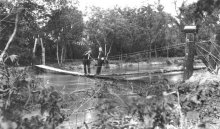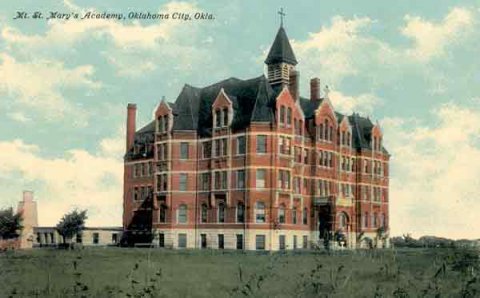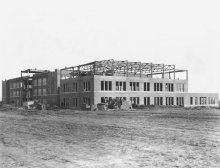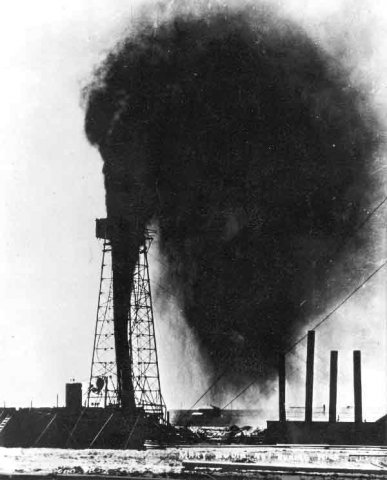Description:
It should have been the home of the state capitol. At least, that was the plan. Home to a promising hill overlooking much of Oklahoma City, the area was named accordingly by B.R. Harrington, a newspaper correspondent for the Wichita Beacon. In 1900, he purchased the land from Miss Tryphosa Boyd, who had been among the early settlers attracted to the area after the Land Run of 1889, when Oklahoma lands were opened by the Federal Government. Her deed bore the signature of President Grover Cleveland.
Harrington platted the 160-acre tract near the old Santa Fe Trail and staked out individual lots for sale. His purpose, said Harrington, was to give “sober and industrious mechanics an opportunity to secure homes.”
The site originally extended from Walker to Santa Fe, and from what is now called SW 22nd to SW 29th, the north boundary being the North Canadian River. Later, it grew to incorporate Penn Ave. on the west, SW 44th on the southern edge, stretching all the way to I-35 on the east.
“At the time Capitol Hill was surveyed, I used a county surveyor, a fellow named Williamson,” Harrington was quoted in the Capitol Hill Beacon 60th Anniversary edition. “He asked me what I was going to call the place. I said, ‘Why, Capitol Hill, of course’.” Thus, Capitol Hill had the distinguishing characteristic of being the only town in Oklahoma considered as a site for the state capitol before it was even a city. Unfortunately, despite vigorous campaigning on the part of Harrington and his associates, the state capitol was located elsewhere.
A key element to the atmosphere of the area was Mount St. Mary’s Academy. Built around the time Capitol Hill was being organized, the cornerstone for the academy was laid in 1903. Local farmers donated their time and services toward building the academy out of brick and stone. It was owned by the Sisters of Mercy, an order of Catholic nuns, who dedicated their lives to running a boarding and day school for girls. Mount St. Mary’s also served as state headquarters for the Sisters of Mercy in Oklahoma. Completed in 1905, 35 girls enrolled for training in academic, musical, cultural and dramatic courses, with the first class graduating in 1907.
Before eventually becoming a suburb of Oklahoma City, Capitol Hill was an incorporated town, with a decree of incorporation being granted on May 3, 1904. George Flanagan was the first mayor of Capitol Hill, from 1906-1910, and it was during his term that citizens of the area petitioned Oklahoma City for annexation. The vote was 1407 to 188 for annexation, although only citizens of Oklahoma City were allowed to vote; Capitol Hill residents were prohibited from taking part in the election.
On December 6, 1909, Capitol Hill became part of Oklahoma City, bringing to the coffers a bonus of more than $12,000 – clearly a boon for Oklahoma City government. However, some Capitol Hill residents had complaints.
“Annexation delayed our improvement and deprived us of many things we could have had long ago,” complained an unnamed citizen in the July 1910 issue of the Capitol Hill Beacon. “We could have had sidewalks, paving and a city hall. Instead, our enemies stuck on you a 15 ½ mill tax levy, most of which was later spent on the north side.”
But, there were improvements. In 1910, the stockyards came to Oklahoma City. City fathers wooed the Morris Packing Company to the area – a major livestock marketing and meat packing plant. In a savvy marketing ploy, people were told they could bring their livestock to market and take care of business at the state house at the same time, both being located in the same place. The meat industry provided many job opportunities for thousands of workers, many of whom settled in the Capitol Hill area.
In July of that year, OG&E received a franchise to install electricity in the Capitol Hill area, with an agreement to leave street lights off during nights when a full moon was shining. Sidewalks were laid, trees planted, and Robinson was the first street to be paved, from SW 22nd to SW 29th.
Growth continued, and Capitol Hill became a community of about 500 homes and 30 businesses, most of which were scattered along South Robinson and what is now SW 27th, leading west toward Mount St. Mary’s. Included in the community were First National Bank, Lee School, churches of different denominations, a fire station, Wheeler and Harrington parks, and a theater. The area did have a downside, however; Robinson had a tendency to flood during spring rains, as the Canadian River spilled over, interrupted traffic, and kept street cars from running. When floodwaters tore through the city dam during the Fall Flood of 1923, over 1500 Capitol Hill residents had to take refuge in churches and school buildings. More than 250 homes were flooded, street car tracks were damaged, and the catastrophe led to a contract to replace the bridge on Walker with one constructed of plate girders.
With the discovery of oil in the area in 1928, big changes were in store for Capitol Hill. No story of oil discovery in Oklahoma is quite as spectacular as that of the Indian Territory Foster Oil unit No. 1 -- otherwise known as the Wild Mary Sudik. The well came in with a dramatic blowout, darkening the sky with what experts estimated to be 10,000-20,000 barrels of oil per day. Eyewitnesses claimed she threw crude so high into the air that it fell like rain in Edmond and in Norman. The well raged for more than a week while engineers desperately worked to bring her under control, finally constructing a harness to cap the geyser.
Oilfield workers -- called “roughnecks” -- came flowing in to the Capitol Hill area, bringing their families with them and increasing demands for housing and education for their children. Unfortunately, Oklahoma’s first oil boom ended when the Great Depression reared its ugly head, and the price of crude oil plunged. Later, the onset of Word War II stimulated the demand for crude, helping to rejuvenate the Oklahoma petroleum industry and Capitol Hill.
When the war ended, building began in earnest as people moved to the area to fill jobs at Tinker Airforce Base and the FAA. During the 1950s, shopping centers sprung up to meet the demands of the growing population. No longer just a home for the “sober and industrious,” the city on the hill had developed into an interesting community with a fascinating history. As the local newspaper noted, “It’s a place where real people live, the unpretentious, honest folks who come to grips with life in the middle ground…where they can see both the depths and heights of human endeavors in sound perspective.”
FURTHER READING:
“89ers Celebration Collector’s Edition,” Capitol Hill Beacon: Oklahoma: 1988.
“Facts & figures relative to Capitol Hill, 1964.” Loose-leaf material. Oklahoma. 1964.
Go South, Grow South: South Oklahoma City Chamber of Commerce, the 26th Annual Progress Edition of the Capitol Hill Beacon. Oklahoma: Capitol Hill Beacon. 1976.
Griffith, Terry L. Oklahoma City: Land Run to Statehood. Charleston, SC: Arcadia Pub. 1999.
Griffith, Terry L. Oklahoma City: Statehood to 1930. Charleston, SC: Arcadia Pub. 2000.
Griffith, Terry L. Oklahoma City: 1930 to the Millennium. Charleston, SC: Arcadia Pub. 2000.
A History of Early Capitol Hill: 60 Years of Community Service. Oklahoma: Capitol Hill Beacon. 1966. Lambert, Paul.
Historic Oklahoma: An Illustrated History. San Antonio, TX: Lammert Publications. 2000. Latrobe, Charles Joseph.
The Rambler in Oklahoma: Latrobe’sTour with Washington Irving. Oklahoma City: Harlow Publishing Corp. 1955.
Oklahoma: The First Hundred Years. Ada, OK: Galaxy Publications. 1988.
The Story of Capitol Hill as Told by Magic Memory Maps. Oklahoma City, OK: Heritage Research. 1995?



